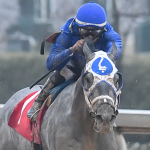
Preakness Quick Sheet: Get to Know the 2021 Preakness Horses

In honor of Black History Month and the contributions made by African Americans to the horse racing industry, Keeneland is unveiling Feb. 23 at Keeneland Library the impressive exhibit The Heart of the Turf: Racing’s Black Pioneers.
The displays highlight the exploits of 80 Black horsemen and women over the past 170 years.

The library, which holds the most far-reaching collection of Thoroughbred-related research materials and artwork on the continent, has been transformed into a gallery featuring more than 100 historical photographs, sculptures, and 16 vertical interpretive panels throughout its main floor that features every facet of African American involvement at racetracks and farms in Kentucky.
Early superstar jockeys such as Isaac Murphy and Jimmy Winkfield are represented, up through active riders such as Kendrick Carmouche and Deshawn Parker. But there also is appreciation for owners, as well as grooms, stable workers, and the staffs that have contributed to the continuation of the sport through the centuries.
“Keeneland Library has one of the largest known photograph collections of early African American horsemen,” noted Roda Ferraro, who curated the exhibition. “It has information and images that researchers have used for decades, and we are pleased to have this opportunity to bring them all together and share them with the public.”
In addition to its own collection, Keeneland is also presenting artwork on loan from the Kentucky Derby Museum, the International Museum of the Horse, and private collections, the latter with help from Lexington’s Cross Gate Gallery. Lexington historian Yvonne Giles came aboard as historical consultant for the artwork and stories shared in the exhibit. Kirk Hoefling served as installation consultant.
“Keeneland is honored to present The Heart of the Turf: Racing’s Black Pioneers, which exemplifies our mission to preserve racing’s rich history, and documents the life and work of African Americans through more than 150 years of our sport,” noted Keeneland president and CEO Shannon Arvin. “We are proud to showcase the significant impact of African Americans on Thoroughbred racing and the history of Lexington.”

The plight of Black jockeys is the most well-known component of African American history in horse racing. In the late 19th and early 20th centuries, these riders dominated the sport, winning its most significant races, including the Kentucky Derby. But as racing became more lucrative, Black jockeys and trainers were forced out of high-level jobs and instead had to take work as grooms and exercise riders.
The history of African Americans specifically in Lexington is also highlighted, to great local interest.
“The whole East End community thrived because skilled horsemen moved here to work at the nearby Kentucky Association racetrack,” said Keeneland Library director Becky Ryder of the track that was built in Lexington in 1828 and thrived for 105 years. “The go-to riders lived within a few blocks of each other here. We feel that history needs to be told, and not just the great jockeys everybody knows, but also the grooms, farriers, trainers, and other attendant industries that supported racing and breeding.
Giles, who has done extensive research for the African Cemetery No. 2 group that has spotlighted Blacks in racing, said, “I am privileged and honored to have been asked to share information I have researched, because in my heart I know how important it is to tell our entire story. Beginning with the Kentucky Association track in Lexington, we are the cradle of racing, and Blacks were the ones that rocked the cradle and kept the industry growing and strong. This information is so important to this library, and to the community at large.”
Added Ferraro, “We could have limited the exhibit to 10 stories, and told them in a certain way. But we chose to share the life and career highlights of as many people as possible to shed light on the varied roles and contributions of African Americans over time. What is so powerful is how these 80 stories run the gamut of roles that are essential to this industry.”
In recent years, organizations such as Phoenix Rising Lexington, African Cemetery No. 2, and the Ed Brown Society have been established to not only share the history of Blacks in horse racing, but to encourage minority participation through education and scholarships. Keeneland Library is encouraging community groups and schools from around the region to visit.

Greg Harbut, a Lexington horseman and a founder of the Ed Brown Society, said, “What is very exciting is that through school programs, the next generation will be able to come here and see this rich history, and be inspired to see what previous generations have done.
“This is a very significant exhibition of the African-American contributions that helped start horse racing, and became part of its foundation in Kentucky. Some of those covered are well-known, but others are the unsung heroes who will be getting the recognition they rightly deserve.”
Ferraro added, “Our hope is that these stories motivate further conversations with community and industry stakeholders about ways to create opportunities for everyone who wants to be a part of this industry. The heightened awareness in recent years is promising.”
The Heart of the Turf: Racing’s Black Pioneers is free and open to the public from Feb. 23-Aug. 31 during Keeneland Library’s operating hours, Monday-Friday from 8:30 a.m. until 4:30 p.m. For those who cannot make it to Lexington, a virtual component is accessible over the internet.
Plans are moving forward to take the exhibit to different venues in other cities when its Lexington run ends.

Please fill out the form below to request information about race horse ownership.